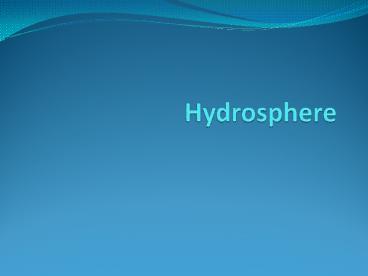Hydrosphere - PowerPoint PPT Presentation
Title: Hydrosphere
1
Hydrosphere
2
Hydrosphere
- The hydrosphere includes all water on Earth.
- The abundance of water on Earth is a unique
feature that clearly distinguishes our "Blue
Planet" from others in the solar system. Not a
drop of liquid water can be found anywhere else
in the solar system. - It is because the Earth has just the right mass,
the right chemical composition, the right
atmosphere, and is the right distance from the
Sun (the "Goldilocks" principle) that permits
water to exist mainly as a liquid.
3
Hydrosphere
- The range of surface temperatures and pressures
of our planet permit water to exist in all three
states solid (ice), liquid (water), and gas
(water vapour). - Most of the water is contained in the oceans and
the high heat capacity of this large volume of
water (1.35 million cubic kilometers) buffers the
Earth surface from large temperature changes - Water is the universal solvent and the basis of
all life on our Planet. It is an essential
life-sustaining resource which led Benjamin
Franklin to comment "When the well's dry, we know
the worth of water."
4
Continental waters
- Continental waters represent only 0.65 of the
total amount of water stored on Earth - However, continental waters have crucial impact
on terrestrial life and human needs, and play a
major role in climate variability
5
Continental waters
- Fresh continental waters are stored in various
reservoirs the snow pack, underground
reservoirs, the root zone (first few meters of
the soil) and vegetation, and as surface waters
(rivers, lakes, man-made reservoirs, wetlands and
inundated areas). - Continental water provide resources for human
consumption and activities (agriculture,
urbanisation, hydroelectric energy resources), as
well as for climate prediction.
6
Watershed
- A watershed is a geographic area in which all
water running off the land drains to a
specific creek, river or stream
7
Watershed vs. Basin
- A basin is a large-scale watershed, such as the
St. Lawrence River basin
8
Cryosphere
- The cryosphere, derived from the Greek word kryo
for "cold" or "too cold", is the term which
collectively describes the portions of the
Earths surface where water is in solid form,
including sea ice, lake ice, river ice, snow
cover, glaciers, ice caps and ice sheets, and
frozen ground (which includes permafrost).
9
Cryosphere
- The cryosphere is an integral part of the global
climate system with important linkages and
feedbacks generated through its influence on
surface energy and moisture fluxes, clouds,
precipitation, hydrology, and atmospheric and
oceanic circulation. - Through these feedback processes, the cryosphere
plays a significant role in global climate
10
Hydro power
- Hydro power is power that is derived from the
force or energy of moving water, which may be
harnessed for useful purposes. - Prior to the widespread availability of
commercial electric power, hydropower was used
for irrigation, and operation of various
machines, such as watermills, textile machines,
sawmills, dock cranes, and domestic lifts.
11
Hydroelectricity
- Hydroelectricity is electricity generated by
hydropower, i.e., the production of power through
use of the gravitational force of falling or
flowing water. It is the most widely used form of
renewable energy. - Once a hydroelectric complex is constructed, the
project produces no direct waste, and has a
considerably different output level of the
greenhouse gas carbon dioxide (CO2) than fossil
fuel powered energy plants
12
Hydroelectricity
- Hydro power is power that is derived from the
force or energy of moving water, which may be
harnessed for useful purposes. - Prior to the widespread availability of
commercial electric power, hydropower was used
for irrigation, and operation of various
machines, such as watermills, textile machines,
sawmills, dock cranes, and domestic lifts.
13
Notes
- The hydrosphere includes all water on Earth
- Most of the water is contained in the oceans and
the high heat capacity of this large volume of
water (1.35 million cubic kilometers) buffers the
Earth surface from large temperature changes - Continental waters represent only 0.65 of the
total amount of water stored on Earth
14
Notes
- Fresh continental waters are stored in various
reservoirs the snow pack, underground
reservoirs, the root zone (first few meters of
the soil) and vegetation, and as surface waters
(rivers, lakes, man-made reservoirs, wetlands and
inundated areas). - Continental water provide resources for human
consumption and activities (agriculture,
urbanisation, hydroelectric energy resources), as
well as for climate prediction.
15
Notes
- A watershed is a geographic area in which all
water running off the land drains to a
specific creek, river or stream - A basin is a large-scale watershed
- The cryosphere is the term which collectively
describes the portions of the Earths surface
where water is in solid form, including sea ice,
lake ice, river ice, snow cover, glaciers, ice
caps and ice sheets, and frozen ground (which
includes permafrost
16
Notes
- The cryosphere plays a significant role in global
climate - Hydro power is power that is derived from the
force or energy of moving water, which may be
harnessed for useful purposes. - Hydroelectricity is electricity generated by
hydropower, i.e., the production of power through
use of the gravitational force of falling or
flowing water. It is the most widely used form of
renewable energy.
17
Questions
- How is the hydrosphere connected to the other
spheres weve seen in class? (Think in terms of
climate change) - Continental waters provide a significant amount
of our fresh water. What are some things we can
do to preserve the quality of continental waters? - Is fresh water a renewable resource? Explain your
answer - What are some advantages of using
hydroelectricity? What are some disadvantages?
(think in terms of the environment)































